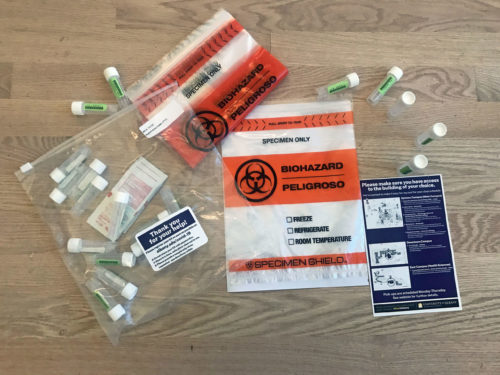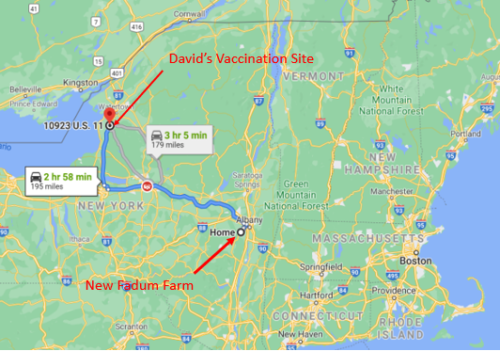Today, I am proud and pleased to live in a corner of the country that respects good science, has enough resources to invest in a strong public health service, and has a government that is able and willing to act. These are three of the four key components needed to keep the COVID-19 virus in check until the vaccines come fully online. More on the fourth key component later. Today’s events give me hope.
This semester, UAlbany has required that both Deborah and I submit weekly test samples of saliva if we are going to be on campus for any reason. Today we drove along the perimeter road around campus heading toward the Alumni House to pick up our test kits. We drove past the state’s COVID-19 testing site where members of the National Guard administer nose swabs to member of the public who have signed up in advance. Several dozen cars are always lined up, waiting. Next, we drove past another facility, also staffed by the National Guard, that administers the vaccine to citizens who meet priority criteria and have signed up in advance. True, vaccine supplies are still limited, but here at least we witness the capacity to administer the vaccine. Indeed, in three days, Deborah will receive her first dose, at this site.
When we arrived at the Alumni House, a staff member hands each of us a plastic bag through the window of our car and we drive away. The whole thing takes less than two minutes. The test kit contains materials for a full semester of weekly tests. The kit has a unique identifier, and we use this code to link our sample to our online records at the University. It contains small vials to contain the saliva, swabs to clean the vials when filled, and plastic bags to seal the test samples before we drop them off at specified times and locations on campus. We will get e-mail messages reminding us when to bring in our test samples. Deborah and I have been assigned to the Sunday test group, so each weekend we will drive downtown to drop off the samples. And then, as our little reward, we’ll take a walk around Washington Park, which is adjacent to the downtown campus.
UAlbany has a school of public health that is co-located with the RNA Research Institute on the university’s East Campus. Scientists working at these sites have worked out a low-cost self-administered saliva test that is very sensitive to the presence of virus and has a small false negative rate, meaning that it almost always correctly identifies persons who carry the virus, and rarely incorrectly fingers those who don’t. Saliva is processed in batches to keep costs down; if a batch tests positive, an individually disaggregated second round of tests identifies who in the sample was carrying the virus. Since the saliva test does occasionally give false positive results, the anyone whose saliva tests positive is referred for more thorough testing.
Any individuals confirmed as positive are required to enter quarantine immediately, while trained staff carefully trace their recent contacts to identify and notify others who may be at risk. The set of contact tracing and testing protocols is supported by an online information system which tracks the state of the pandemic across campus. The system is intended to nip the spread of the infection in the bud and if the scale of infection is low (say, as low as it was back in September), these protocols and tests will do an excellent job of holding down further spread.
The key to this kind of testing, tracking, and monitoring system is that it follows a known, defined population that is in frequent contact with one another. It seems to me that other settings like elementary and secondary schools or work sites could use this kind of monitoring technology to make themselves and all of us safer.
David and Deborah’s drive around campus made it clear that we now have in hand three of the critical components necessary to contain the spread of the COVID-19 virus in Upstate New York around New Fadum Farm: (1) Respect for good science, (2) Sufficient resources to invest in a strong public health service, and (3) Health authorities that are able and willing to act. All we need now is the critical fourth component, the social discipline and endurance to observe protocols, get tested, and do what it takes to keep us all safe. I am hopeful that with the change in leadership at the Federal level we will be getting some much-needed help in this critical fourth area.
This Story Has a Lesson
In March of 2020, near the start of this pandemic, Ali’s model identified a comprehensive test and quarantine policy as the safest and best way to contain the COVID-19 virus. The relatively inexpensive and effective screening technologies are becoming available. Our society is now making the public health investments needed to create and administer both focused and wide-scale testing coupled to a contact tracing and quarantine system. Here in Upstate New York, we are lucky to have authorities that are willing to act decisively. It is now up to WE THE PEOPLE to make this all work by being aware of and conforming to public health protocols.
Read More to Dig Deeper
Writing this diary entry caused me to think back to the start of Diaries During Lockdown project. In March of 2020, Ali ran a set of simulations that demonstrated the effectiveness of a comprehensive test, trace and quarantine system. The figure below is one of the set of policy tests that has been posted along with every diary entry that we have written since last April (you can see the full set of policies by finding and clicking on the link for Policies to control Corona. ) In this figure Ali repeats an earlier simulation run but in this run he implements a population-wide program of frequent testing with referral to quarantine to create what he called “Scenario Three”. Over the course of a full year, frequent testing of the entire population reduces cumulative symptomatic patients and deaths by several orders of magnitude. Why is it that after all these months of the pandemic, policies like this have not been fully implemented?

There are several reasons. First, the technology of low-cost screening tests with acceptable false positive and false negative rates was not yet fully worked out. For example, the “Egg Club Protocol” that we proposed for small networks back in the summer relied on body temperature or a use of one of the online self-report screenings as a proxy for a more accurate test (see these diaries, “Converting the ‘Egg Club’ to a COVID-19 Safe Trusted Network” July 1, 2020). Second, our public health system lacked the infrastructure and human resources to conduct comprehensive contact tracing especially with regard to enforcing quarantine rules. Third, our governance structures at the University, county level, and state level were unable for technical or administrative reasons to define and enforce the necessary testing, quarantining, and other safety protocols. We still have the time to bear down and add the additional effort and resources to create a safer society in the period between now and when the vaccines are fully administered.




